Small overlap front: driver-side
Rating applies to 2014-20 models
Tested vehicle: 2014 Mitsubishi Outlander 2.4 SE 4-door 4wd
The Mitsubishi Outlander was redesigned for the 2014 model year. These ratings also apply to the Outlander PHEV (plug-in hybrid electric) variant, which was introduced in the 2018 model year.
| Overall evaluation | |
|---|---|
| Structure and safety cage | |
| Driver injury measures | |
| Head/neck | |
| Chest | |
| Hip/thigh | |
| Lower leg/foot | |
| Driver restraints and dummy kinematics |
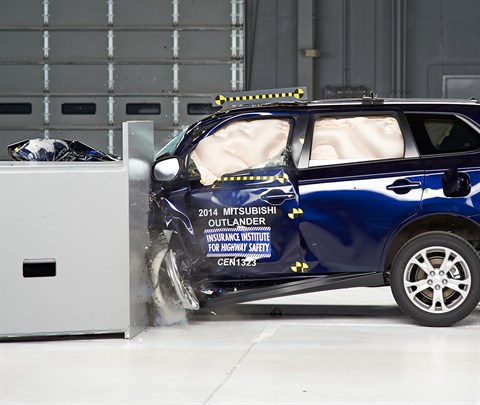
Action shot taken during the driver-side small overlap frontal crash test.
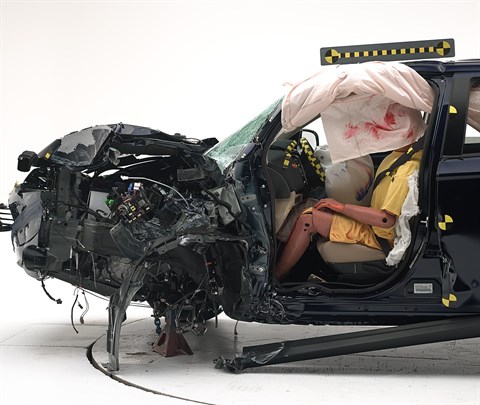
The dummy's position in relation to the door frame, steering wheel, and instrument panel after the crash test indicates that the driver's survival space was maintained reasonably well.
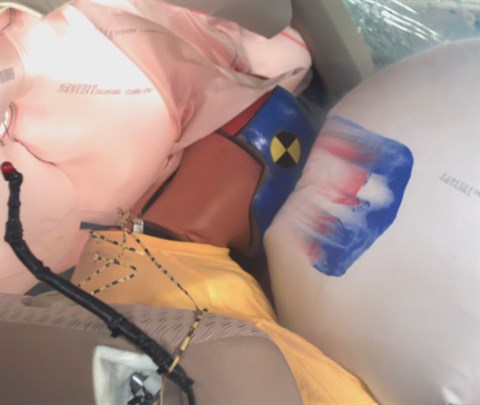
The dummy’s head contacted the frontal airbag but then slid off the left side. The side curtain airbag extended far enough forward toward the A-pillar to protect the head from contact with side structure.
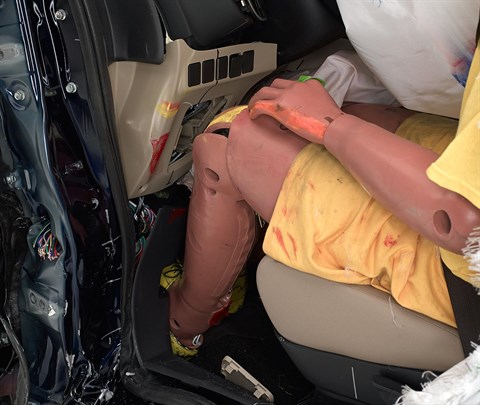
Intrusion into the driver's space was reasonably well controlled, and risk of injuries to the dummy's legs and feet was low.
Measures of occupant compartment intrusion on driver side
| Test ID | CEN1323 |
|---|---|
| Lower occupant compartment | |
| Lower hinge pillar max (cm) | 16 |
| Footrest (cm) | 10 |
| Left toepan (cm) | 6 |
| Brake pedal (cm) | 4 |
| Parking brake (cm) | |
| Rocker panel lateral average (cm) | 6 |
| Upper occupant compartment | |
| Steering column | 0 |
| Upper hinge pillar max (cm) | 12 |
| Upper dash (cm) | 10 |
| Lower instrument panel (cm) | 11 |
Driver injury measures
| Test ID | CEN1323 |
|---|---|
| Head | |
| HIC-15 | 81 |
| Peak gs at hard contact | no contact |
| Neck | |
| Tension (kN) | 0.8 |
| Extension bending moment (Nm) | 7 |
| Maximum Nij | 0.19 |
| Chest maximum compression (mm) | 24 |
| Femur (kN) | |
| Left | 4.8 |
| Right | 1.6 |
| Knee displacement (mm) | |
| Left | 6 |
| Right | 1 |
| Knee-thigh-hip injury risk (%) | |
| Left | 3 |
| Right | 0 |
| Maximum tibia index | |
| Left | 0.63 |
| Right | 0.33 |
| Tibia axial force (kN) | |
| Left | 2.3 |
| Right | 2.5 |
| Foot acceleration (g) | |
| Left | 61 |
| Right | 66 |
Small overlap front: passenger-side
Rating applies to 2014-20 models
Tested vehicle: 2018 Mitsubishi Outlander 2.4 ES 4-door 4wd
The Mitsubishi Outlander was redesigned for the 2014 model year. These ratings also apply to the Outlander PHEV (plug-in hybrid electric) variant, which was introduced in the 2018 model year.
| Overall evaluation | |
|---|---|
| Structure and safety cage | |
| Passenger injury measures | |
| Head/neck | |
| Chest | |
| Hip/thigh | |
| Lower leg/foot | |
| Passenger restraints and dummy kinematics | |
| Driver injury measures | |
| Head/neck | |
| Chest | |
| Hip/thigh | |
| Lower leg/foot | |
| Driver restraints and dummy kinematics |
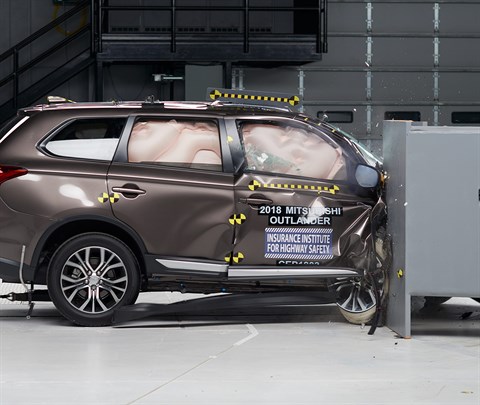
Action shot taken during the passenger-side small overlap frontal crash test.
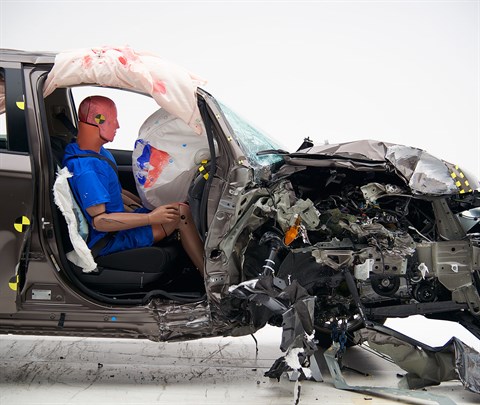
The dummy's position in relation to the door frame and dashboard after the crash test indicates that the passenger's survival space was maintained reasonably well.
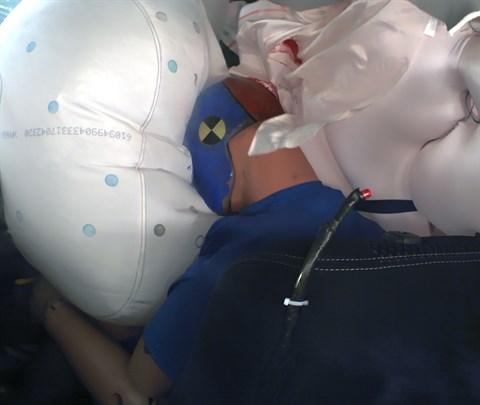
The frontal and side curtain airbags worked well together to keep the head from coming close to any stiff structure or outside objects that could cause injury.
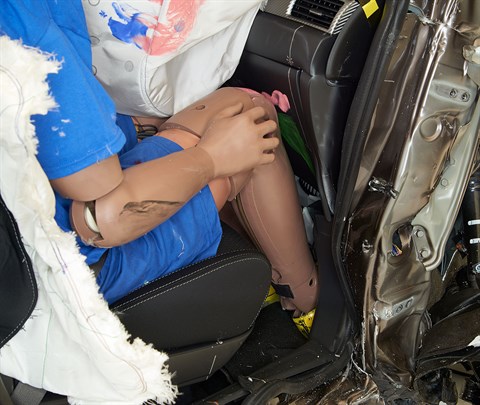
Despite intrusion of the dashboard and door hinge pillar, risk of injuries to the dummy's legs and feet was low.
Measures of occupant compartment intrusion on passenger side
| Test ID | CEP1803 |
|---|---|
| Lower occupant compartment | |
| Lower hinge pillar max (cm) | 21 |
| Footrest (cm) | 12 |
| Right toepan (cm) | 9 |
| Center toepan (cm) | 4 |
| Rocker panel lateral average (cm) | 8 |
| Upper occupant compartment | |
| Center dash (cm) | 6 |
| Upper hinge pillar max (cm) | 17 |
| Upper dash (cm) | 9 |
| Right lower dash (cm) | 9 |
Passenger injury measures
| Test ID | CEP1803 |
|---|---|
| Head | |
| HIC-15 | 161 |
| Peak gs at hard contact | no contact |
| Neck | |
| Tension (kN) | 0.7 |
| Extension bending moment (Nm) | 11 |
| Maximum Nij | 0.17 |
| Chest maximum compression (mm) | 12 |
| Femur (kN) | |
| Left | 1.6 |
| Right | 3.1 |
| Knee displacement (mm) | |
| Left | 2 |
| Right | 1 |
| Knee-thigh-hip injury risk (%) | |
| Left | 0 |
| Right | 1 |
| Maximum tibia index | |
| Left | 0.27 |
| Right | 0.50 |
| Tibia axial force (kN) | |
| Left | 2.5 |
| Right | 1.2 |
| Foot acceleration (g) | |
| Left | 33 |
| Right | 63 |
Driver injury measures
| Test ID | CEP1803 |
|---|---|
| Head | |
| HIC-15 | 59 |
| Peak gs at hard contact | no contact |
| Neck | |
| Tension (kN) | 0.6 |
| Extension bending moment (Nm) | 6 |
| Maximum Nij | 0.14 |
| Chest maximum compression (mm) | 28 |
| Femur (kN) | |
| Left | 0.5 |
| Right | 0.4 |
| Knee displacement (mm) | |
| Left | 1 |
| Right | 1 |
| Knee-thigh-hip injury risk (%) | |
| Left | 0 |
| Right | 0 |
| Maximum tibia index | |
| Left | 0.42 |
| Right | 0.22 |
| Tibia axial force (kN) | |
| Left | 1.5 |
| Right | 1.4 |
| Foot acceleration (g) | |
| Left | 31 |
| Right | 37 |
How the passenger-side small overlap front test is conducted
Moderate overlap front: original test
Rating applies to 2014-20 models
Tested vehicle: 2014 Mitsubishi Outlander 2.4 SE 4-door 4wd
The Mitsubishi Outlander was redesigned for the 2014 model year. Moderate overlap frontal ratings are assigned by the Institute based on a test conducted by Mitsubishi as part of frontal crash test verification. (The vehicle tested by Mitsubishi was designated as a 2013 model but included all the design changes of the 2014 models.)
These ratings also apply to the Outlander PHEV (plug-in hybrid electric) variant, which was introduced in the 2018 model year.
| Overall evaluation | |
|---|---|
| Structure and safety cage | |
| Driver injury measures | |
| Head/neck | |
| Chest | |
| Leg/foot, left | |
| Leg/foot, right | |
| Driver restraints and dummy kinematics |
Measures of occupant compartment intrusion on driver side
| Test ID | VTF1223 |
|---|---|
| Footwell intrusion | |
| Footrest (cm) | 3 |
| Left (cm) | 7 |
| Center (cm) | 9 |
| Right (cm) | 8 |
| Brake pedal (cm) | 9 |
| Instrument panel rearward movement | |
| Left (cm) | 1 |
| Right (cm) | 1 |
| Steering column movement | |
| Upward (cm) | -2 |
| Rearward (cm) | 0 |
| A-pillar rearward movement (cm) | 0 |
Driver injury measures
| Test ID | VTF1223 |
|---|---|
| Head | |
| HIC-15 | 127 |
| Peak gs at hard contact | 18 |
| Neck | |
| Tension (kN) | 1.3 |
| Extension bending moment (Nm) | 12 |
| Maximum Nij | 0.23 |
| Chest maximum compression (mm) | 31 |
| Legs | |
| Femur force - left (kN) | 1.4 |
| Femur force - right (kN) | 1.5 |
| Knee displacement - left (mm) | 1 |
| Knee displacement - right (mm) | 0 |
| Maximum tibia index - left | 0.39 |
| Maximum tibia index - right | 0.41 |
| Tibia axial force - left (kN) | 2.2 |
| Tibia axial force - right (kN) | 2.7 |
| Foot acceleration (g) | |
| Left | 59 |
| Right | 107 |
Side: original test
Rating applies to 2014-20 models
Tested vehicle: 2014 Mitsubishi Outlander GT 4-door 4wd with standard front and second row head curtain airbags and standard front seat-mounted torso airbags
The Mitsubishi Outlander was redesigned for the 2014 model year. Side ratings are assigned by the Institute based on a test conducted by Mitsubishi as part of side crash test verification. (The vehicle tested by Mitsubishi was designated as a 2013 model but included all the design changes of the 2014 models.)
These ratings also apply to the Outlander PHEV (plug-in hybrid electric) variant, which was introduced in the 2018 model year.
| Overall evaluation | |
|---|---|
| Structure and safety cage | |
| Driver injury measures | |
| Head/neck | |
| Torso | |
| Pelvis/leg | |
| Driver head protection | |
| Rear passenger injury measures | |
| Head/neck | |
| Torso | |
| Pelvis/leg | |
| Rear passenger head protection | |
Measures of occupant compartment intrusion on driver side
| Test ID | VTS1226 |
|---|---|
| B-pillar to longitudinal centerline of driver's seat (cm) | -7.5 |
| Negative numbers indicate the amount by which the crush stopped short of the seat centerline. | |
Driver injury measures
| Test ID | VTS1226 |
|---|---|
| Head HIC-15 | 493 |
| Neck | |
| Tension (kN) | 0.9 |
| Compression (kN) | 0.1 |
| Shoulder | |
| Lateral deflection (mm) | 47 |
| Lateral force (kN) | 1.9 |
| Torso | |
| Maximum deflection (mm) | 37 |
| Average deflection (mm) | 32 |
| Maximum deflection rate (m/s) | 4.70 |
| Maximum viscous criterion (m/s) | 0.43 |
| Pelvis | |
| Iliac force (kN) | 3.2 |
| Acetabulum force (kN) | 2.0 |
| Combined force (kN) | 5.0 |
| Left femur | |
| L-M force (kN) | 0.3 |
| L-M moment (Nm) | 74 |
| A-P moment (Nm) | 20 |
Passenger injury measures
| Test ID | VTS1226 |
|---|---|
| Head HIC-15 | 124 |
| Neck | |
| Tension (kN) | 0.2 |
| Compression (kN) | 0.5 |
| Shoulder | |
| Lateral deflection (mm) | 33 |
| Lateral force (kN) | 1.8 |
| Torso | |
| Maximum deflection (mm) | 27 |
| Average deflection (mm) | 20 |
| Maximum deflection rate (m/s) | 2.80 |
| Maximum viscous criterion (m/s) | 0.25 |
| Pelvis | |
| Iliac force (kN) | 1.2 |
| Acetabulum force (kN) | 2.0 |
| Combined force (kN) | 2.6 |
| Left femur | |
| L-M force (kN) | 0.4 |
| L-M moment (Nm) | 44 |
| A-P moment (Nm) | 13 |
Roof strength
Rating applies to 2014-20 models
Tested vehicle: 2014 Mitsubishi Outlander 2.4 SE 4-door 4wd
Rating applies to both the Outlander (tested) and Outlander PHEV (plug-in hybrid electric) versions.
| Overall evaluation | |
|---|---|
| Curb weight | 3,438 lbs |
| Peak force | 17,034 lbs |
| Strength-to-weight ratio | 4.95 |
Head restraints & seats
Seat type: Manual cloth seat
| Overall evaluation | |
|---|---|
| Dynamic rating | |
| Seat/head restraint geometry |
| Seat type | Manual cloth seat |
|---|---|
| Geometry | |
| Backset (mm) | 26 |
| Distance below top of head (mm) | -4 |
| Seat design parameters | |
| Pass/fail | Pass |
| Max T1 acceleration (g) | 10.1 |
| Head contact time (ms) | 55 |
| Force rating | 1 |
| Neck forces | |
| Max neck shear force (N) | 0 |
| Max neck tension (N) | 307 |
How the head restraint & seat test is conducted
Currently, IIHS tests apply only to front seats.
